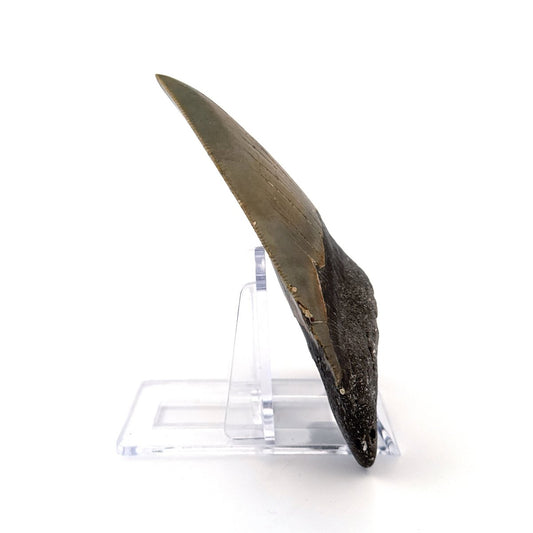Collection: Megalodon fossil teeth
Megalodon, scientifically known as Carcharocles megalodon, is perhaps one of the most iconic and awe-inspiring creatures to have ever lived in Earth's oceans. This colossal shark, often referred to as the "megatooth shark," prowled the ancient seas during the Miocene and Pliocene epochs, approximately 23 to 2.6 million years ago.
-
Megalodon tooth fossil (3.19") - Miocene, USA
Regular price €115,00 EURRegular priceUnit price / per -
Megalodon tooth fossil (4.28") - Miocene, USA
Regular price €165,00 EURRegular priceUnit price / per -
Megalodon tooth fossil (4.17") - Miocene, USA
Regular price €160,00 EURRegular priceUnit price / per -
Megalodon tooth fossil (4.39") - Miocene, USA
Regular price €150,00 EURRegular priceUnit price / per -
Megalodon tooth fossil (4.63") - Miocene, USA
Regular price €180,00 EURRegular priceUnit price / per -
Megalodon tooth fossil (5.61") - Miocene, USA
Regular price €295,00 EURRegular priceUnit price / per -
Megalodon tooth fossil (3.70") - Miocene period, USA
Regular price €125,00 EURRegular priceUnit price / per -
Rare Megalodon tooth fossil from Italy on Matrix, Miocene period (2.91")
Regular price €120,00 EURRegular priceUnit price / per -
Rare Megalodon tooth fossil from Italy on Matrix, Miocene period (2.64")
Regular price €120,00 EURRegular priceUnit price / per -
4.80" Megalodon tooth fossil from USA
Regular price €180,00 EURRegular priceUnit price / per -
4.92" Megalodon tooth fossil from USA
Regular price €185,00 EURRegular priceUnit price / per -
4.85" Megalodon tooth fossil from USA
Regular price €175,00 EURRegular priceUnit price / per -
4.36" Megalodon tooth fossil from USA
Regular price €165,00 EURRegular priceUnit price / per -
Megalodon tooth fossil (4.10") - Miocene, USA
Regular price €155,00 EURRegular priceUnit price / per
About Megalodon
Let's delve into the fascinating world of Megalodon
Physical Characteristics
Megalodon was a true giant of the seas, with estimates suggesting that it reached lengths of up to 60 feet (18 meters) or more, making it one of the largest predatory sharks to have ever existed. Its massive size dwarfed even the largest modern great white sharks. Megalodon had a robust, torpedo-shaped body, powerful jaws armed with rows of serrated teeth, and a tail adapted for swift and efficient swimming. Its teeth, some measuring over 7 inches (18 centimeters) in length, were triangular and razor-sharp, perfectly evolved for grasping and slicing through prey.
Habitat and Distribution
Megalodon was a cosmopolitan predator, inhabiting oceans worldwide during its heyday in the Miocene and Pliocene epochs. Fossil remains of Megalodon have been found on every continent except Antarctica, indicating a broad distribution across ancient marine environments. These massive sharks likely patrolled coastal areas, continental shelves, and open ocean regions, preying on a variety of marine mammals, fish, and other large prey.
Feeding and Behavior
Megalodon was a formidable apex predator, occupying the top of the marine food chain during its time. Its diet likely consisted of a wide range of prey, including whales, seals, sea turtles, and large fish. Megalodon's powerful jaws and immense bite force enabled it to crush bones and tear through flesh with ease, making it a highly efficient hunter. Scientists speculate that Megalodon may have employed ambush tactics to surprise its prey, launching swift and devastating attacks from below.
Extinction and Legacy
Despite its dominance as a top predator for millions of years, Megalodon eventually disappeared from the oceans around 2.6 million years ago, towards the end of the Pliocene epoch. The exact cause of Megalodon's extinction remains uncertain, with factors such as changes in oceanic temperature, declining prey availability, and competition from other marine predators likely playing a role. Nevertheless, Megalodon's legacy endures in the fossil record and in popular culture, captivating the imagination of people worldwide.
Scientific Study and Exploration
The study of Megalodon has captivated scientists and enthusiasts for centuries, inspiring numerous research efforts and exploration endeavors aimed at unraveling the mysteries of this ancient giant. Paleontologists analyze Megalodon fossils, including teeth, vertebrae, and calcified cartilage, to reconstruct its anatomy, behavior, and evolutionary history. Advances in paleontological techniques, such as computer modeling and genetic analysis, continue to shed light on Megalodon's biology and ecology, deepening our understanding of this enigmatic predator.
Through its colossal size, fearsome jaws, and formidable hunting prowess, Megalodon remains an enduring symbol of the prehistoric world, sparking wonder and fascination in people of all ages. As scientists continue to study Megalodon and its place in Earth's history, the legacy of this ancient giant will continue to inspire curiosity and awe for generations to come.
Megalodon fossil teeth




























